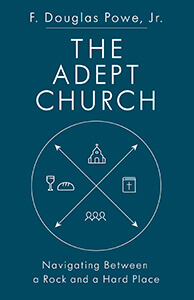Congregations that want to move forward and live more missionally need to understand and embody four key characteristics, says F. Douglas Powe, director of the Lewis Center and the James C. Logan Chair in Evangelism (an E. Stanley Jones Professorship) at Wesley Theological Seminary. Missional congregations must be connected to their context, bound as a community by a common story, open to positive innovation, and guided by a godly vision.
Understanding the four key characteristics of missional congregations can help a congregation that wants to move forward and live more missionally. Missional congregations are incarnational, sacramental, creational, and eschatological. Translating these theological terms in everyday language, we can say that missional congregations are contextual, communal, innovative, and visionary.
1. Contextual
The opening chapter of John’s Gospel is helpful in understanding what it means to be incarnational or contextual. Perhaps you are familiar with these words from the King James Bible: “The Word was made flesh and dwelt among us” (John 1:14a). Eugene Peterson’s presentation of the Bible in contemporary language puts it this way: “The Word became flesh and blood, and moved into the neighborhood” (John 1:14a MSG). This image of “moving into the neighborhood” captures in everyday language the nature of the incarnation of Christ. Jesus is present and real right where we live, right before our eyes. We literally can reach out and touch Jesus. And Jesus in return can touch us.
What does it mean to be an incarnational or contextual church? An incarnational church is present and real right where we live. Those in the community can touch the church. And the church can touch them. For a church to be missional, to participate in God’s transforming work, it must be contextual. It must touch others and be touched by others.
2. Communal
We use the word community in relation to many different entities in society and the church. Most of us participate in several different communities at the same time. We may be part of a work community, a community where we live, some other organization like a sorority or fraternity, and so on. Each of these different types of communities is bound together by a common story, a shared narrative that shapes the ways members of the community engage one another.
The church is no different. It also has a story with colorful characters. It has traditions and practices that bond individuals together. For many Christians, baptism and Communion are the central elements of those traditions and practices. Baptism and Communion recall the broader Christian story, but they also capture the story of the local congregation. The importance of baptism and Communion to the Christian community cannot be understated. Through baptism one becomes part of the great cloud of witnesses across Christian traditions, but also part of a specific local congregation. Partaking of Communion, one continues to live out the connection between God and neighbor.
In both baptism and Communion, the community shares its common story and continues to participate in that story. In baptism, we enter a community that commits to form us as we grow in discipleship. In Communion, we live out our discipleship by sharing God’s grace as it has been shared with us. Although baptism is a one-time event, the work of formation is ongoing. Communion — whether we partake weekly, monthly, or according to some other schedule — gives us an opportunity to be God’s ambassadors. At the Lord’s Table, we are renewed for that work. Communion nourishes us for our work as disciples. That includes accepting our individual and communal calling to be God’s ambassadors in the community. We truly must give ourselves away as Jesus gave himself away for us.
3. Innovative
Through the prophet Jeremiah, God reveals that something new is going to take place. God is making a new covenant. The old covenant was created to establish Israel as a nation. The laws were given to Moses on stone tablets. The new covenant will be written in the minds and hearts of God’s people (Jer 31:31-33). The new covenant is an innovation on the old covenant. It is created in a way that maintains boundaries and order but allows a certain freedom since it is not literally written in stone. Innovation is not simply doing away with everything that has come before it. Innovation creates space for a new thing to take place by lifting some of the confining characteristics of what has gone before, while continuing to stay in alignment with the same purpose or mission.
In Jeremiah 31, God reveals that the old covenant is going away and a new one is coming. The new covenant is still about God’s laws. The expectation is that everyone will embody these laws in new ways and not just see them as words written on stone. The point of innovation is not just to do something new but to do something new that moves toward a positive change. When he healed on the Sabbath, Jesus offered an innovative interpretation of the law, one that would benefit the community, while the temple leaders who challenged him still saw the law as written in stone.
4. Visionary
The book of Habakkuk is helpful when thinking about visioning. Habakkuk questioned God about the dire circumstances of his people. “And then God answered: Write this. Write what you see. Write it out in big block letters so that it can be read on the run. This vision-message is a witness pointing to what’s coming. It aches for the coming — it can hardly wait! And it doesn’t lie. If it seems slow in coming, wait. It’s on its way. It will come right on time” (Hab 2:2-3 MSG). Imagine seeing hopes and dreams about how your congregation can participate in God’s work of transformation written in big block letters so you cannot miss it, no matter where you may be!
The truth is most congregations have a vision. But is it a vision that pulls them toward the future God is bringing to fruition? Is that vision filed away in a desk drawer and rarely mentioned unless someone happens to bring it up? Congregations must always live in the tension between where they are in the present and where they need to be in the future. Unfortunately, too many churches are satisfied with where they are and have no vision for where they need to be in the future. A vision that truly points toward God’s future requires more than lip service.
Congregations are constantly having to think about how they can continue to move positively into the future instead of receding in a negative direction. For congregational leaders, this constant need to move forward for fear of falling backward can feel overwhelming. They need practical first steps to help their congregations become more missional. Here are a few questions to help a congregation figure out where it needs to move.
- What is the story the congregation believes about itself? What is the story outsiders believe about the congregation? Are we willing to change our story to connect with others? If yes, how?
- Who is the congregation seeking to touch beyond the church? How are we allowing others to touch us beyond the church?
- Are we willing to do anything differently? If yes, what? If no, is it time for us to close?
- Are we becoming complacent in the way we touch lives and they touch our lives?
- Are we continuing to discern where God is leading us? If yes, how?
These questions are a way of entering into a discussion around being missional. We need more congregations that are not hunkering down and just living out their time, congregations that are truly committed to participating in God’s transforming work. It is true that congregations cannot escape being stuck between a rock and a hard place, but they can decide a missional way of moving forward.
 This material is adapted from The Adept Church: Navigating Between a Rock and a Hard Place (Abingdon Press, 2020), available at Abingdon Press, Cokesbury, and Amazon. Used by permission.
This material is adapted from The Adept Church: Navigating Between a Rock and a Hard Place (Abingdon Press, 2020), available at Abingdon Press, Cokesbury, and Amazon. Used by permission.
Related Resources
- Is Your Congregation a Swamp, a Reservoir, or a Canal? by Doug Powe
- 4 Key Practices of Community Engagement by Doug Powe and Sam Marullo






